A pier for Newburgh? A train for Andover?
Infrastructure. Will the Newburgh Landing Pier see well-heeled travelers disembark from cruise ships? Will a long-defunct rail line that runs through Andover once again carry passengers to the Poconos? Big dreams – and uncertainty – tango as towns look to tap into federal infrastructure money
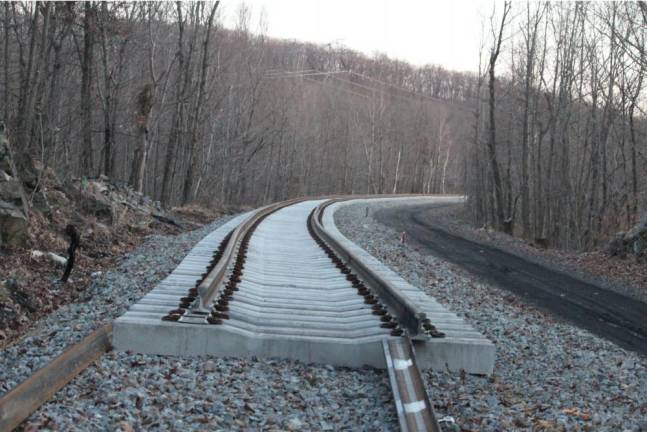
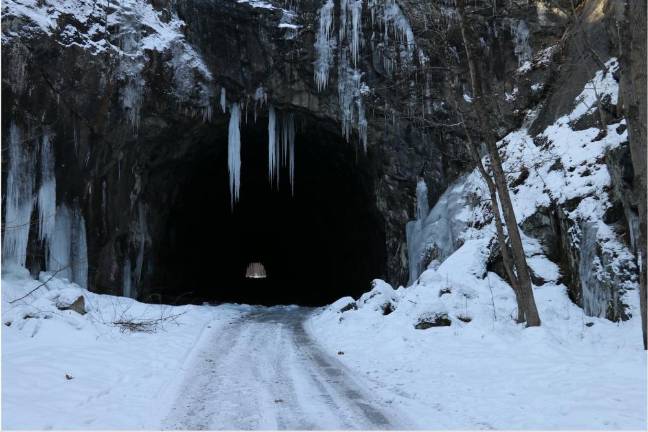
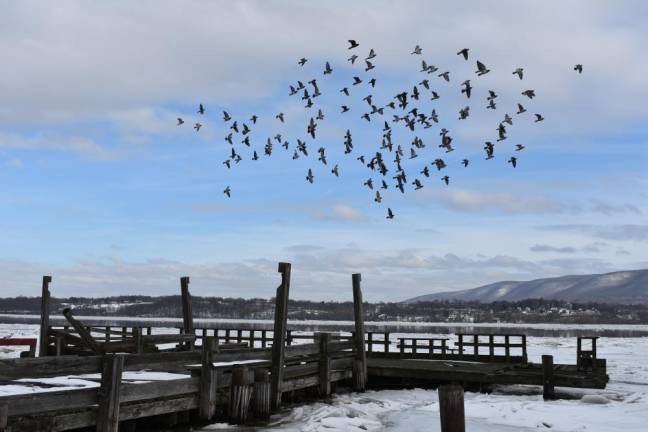
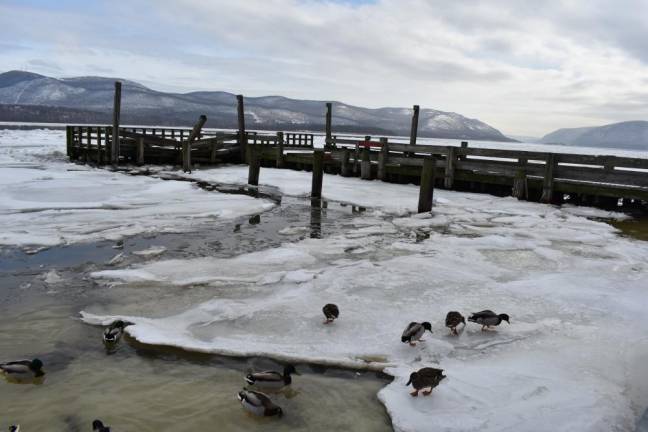
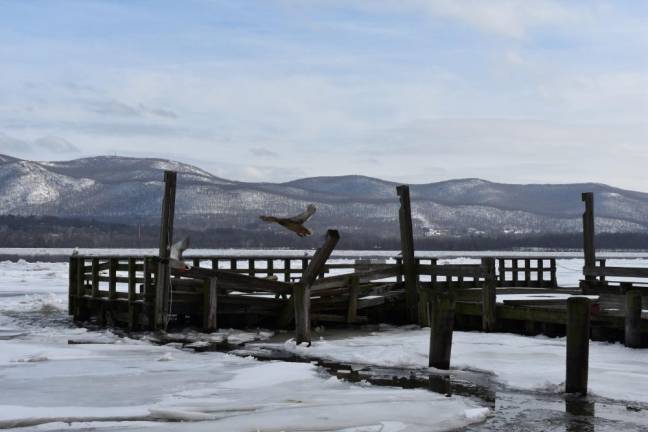
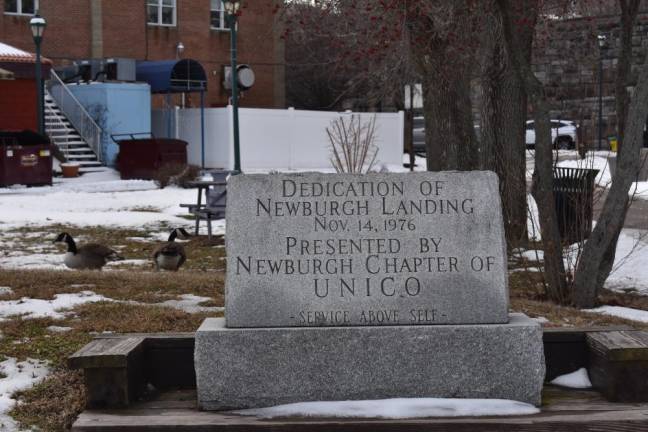
A deep-water port re-embraces its maritime origins
The dream:
Alexandra Church remembers the Clearwater putting down anchor, and the annual spring festival celebrating the shad’s migration up the Hudson, last held in 1993, when authorities deemed the fish unfit to eat.
“Even when I was a kid, there wasn’t much going on on the waterfront, but there was always the Newburgh landing, where the public can go out to touch the water,” said Church, who is now the director of planning and development for the City of Newburgh, N.Y. “We’d all be out on the landing.”
The Newburgh Landing Pier has been an off-limits eyesore since the winter of 2014 inflicted severe ice floe damage. With $4 million of federal infrastructure money on the table, the crumbling pier could be demolished at last and replaced by a much larger pier fresh out of the public design process. The new structure, designed by Hastings-on-Hudson-based architect Edward M. Weinstein, features a pair of extended arms that reach far further out into the river than its predecessor, capitalizing on Newburgh’s distinction as the only deep-water port between New York City and Albany. It looks like a massive tuning fork, one of whose arms terminates in a 90-by-30-foot floating dock that will be the permanent home of the Newburgh-Beacon ferry, linking Newburgh to the city and points east.
The other arm is a fixed pier that can accommodate large cruise ships on the downriver side, opposite a handful of mooring slips for recreational boaters to dock and dine. In addition to its primary function as a transit hub, the new pier will also feature an overwater park with shaded seating, and a venue for outdoor entertainment and community events.
These days, a locked chain link fence keeps passersby off the gap-tooth pier. The walkway leading to it is socked in by snow, and the brick park building nearby is adorned with graffiti.
“We have the best view of the Hudson River of all the river cities of the Hudson Valley, and when you look at our piers, they’re in dire need of repair,” said Newburgh Mayor Torrance Harvey, in a press conference last spring in front of the crumbling pier. “The infrastructural investments will also bring about employment – jobs that are well needed in the city of Newburgh.”
Now that Newburgh is embracing its maritime heritage, a reborn Landing has the potential to go from a reminder of past failures to a crucial asset and catalyst for the city’s further revitalization. Church hopes to see historic sailing ships like the 106-foot sloop the Clearwater – a full-size replica of an 18th century merchant vessel – back in port for educational visits. Newburgh will also be able to welcome day liners and cruise ships.
The idea of well-heeled visitors walking around town for the day, window-shopping and eating at restaurants, is an attractive proposition – on both sides. “American Cruise Lines is always open to adding new stops at docks/ports and many wonderful small towns along our domestic U.S. cruise itineraries,” said Alexa Paolella, public relations manager for a cruise line that sends leaf peeper cruises up the Hudson each fall, when asked about adding Newburgh. The current itinerary hits West Point and Kingston on the way north to Troy; and Hyde Park and Sleepy Hollow on the way back to New York City, skipping Newburgh. Piermont, in Rockland County, wanted to become a cruise stop last fall, but the village didn’t have the $350,000 to upgrade its pier to withstand potential contact with a cruise ship, which are up to 270 feet long. Newburgh’s new pier was designed specifically with these ships in mind.
“We’re delighted the federal government and Metro-North are investing in a new Newburgh ferry landing,” said Wiley Norvell, spokesman for NY Waterway, the contractor that has run ferry service since 2004. “This is a big boost for safe, reliable, and comfortable cross-Hudson ferry service.” The ferry carries commuters 10 minutes across the river to Beacon for $1.75, starting at 5:36 a.m. on weekdays to catch the first train to the city. It’s been operating from a floating dock in an ad-hoc set-up in which Metro-North pays Newburgh to rent land from a private landowner on the waterfront, an expense that will disappear once the ferry is re-homed at the city-owned pier.
The reality:
The project is fully designed and shovel-ready, said Church, but when the demolition ball will fly she has no idea. Usually the press finds out before she does. “I can’t really understand this infrastructure debacle the federal government has gotten itself in,” she said.
The $4 million Newburgh Landing Pier Project is one of 10 infrastructure projects across the Hudson Valley sponsored by Congressman Sean Patrick Maloney, who holds sway as a member of the House Transportation and Infrastructure Committee. The landing was listed in an early version of the legislation as a project to be funded in 2022, but calls to Maloney’s office to confirm that timeline were not returned by press time. Orange County, the project sponsor, submitted the request last April but had not heard anything about its status by February 2, according to Justin Rodriguez, assistant to Orange County Executive Steve Neuhaus.
In the meantime, ducks, pigeons, and a couple geese have made their home around the abandoned pier.
Andover, gateway to the Poconos
The dream:
The old time railroaders said it was a pipe dream. Once a railroad is dead, it’s dead, and you can’t bring it back to life. And the Lackawanna Cutoff, a 28-mile dirt path through North Jersey that hasn’t seen a train since 1979, was dead.
Still, the quixotic push to revive the dormant rail line – which once carried passengers from New York City due west to the industrial center of Scranton, Pa. – lurched along for decades at an agonizingly slow pace. Then came the Bipartisan Infrastructure Law, and just like that, the restoration of a seven-mile stretch of the Lackawanna Cutoff from Port Morris Junction to Andover, N.J., a $62 million New Jersey Transit project that had been stalled for years, leapfrogged to the top of the priority list. The segment, along with a new station in Andover, should be completed by the fourth quarter of 2026, said Jim Smith, director of media relations for NJ Transit.
The clock is ticking with new urgency, because the Lackawanna Cutoff has suddenly become critical infrastructure. Amtrak, the nation’s largest passenger railroad, is newly flush with an unprecedented $66 billion in federal funds and pondering 39 new routes nationwide. A top contender is a 136-mile corridor that would, once again, run three round trips a day from New York City to Scranton. The Lackawanna Cutoff is a crucial segment of that highly hyped Scranton line, which would open up the Poconos to hundreds of thousands of new visitors. Amtrak has said it can complete the new railroad in three years from the time it gets final approvals.
In the first sign of forward progress on the Lackawanna Cutoff in years, three companies bid in late January to prepare the last three miles of track bed to Andover, and repair the abandoned, 110-year-old Roseville Tunnel in Byram, N.J. The latter job, in addition to installing drainage ditches, lighting and a communication system, involves lopping off the ends of the 1,024-foot tunnel, said Chuck Walsh, president of the North Jersey Rail Commuter Association since the 1980s. That’s the only way to avoid having to install a ventilation shaft, requisite for tunnels over 1,000 feet, which involves drilling into the rock bed – a process that engineers worry might cause instability, said Walsh. The bids ranged from $32.4 million to $48.9 million, reported the Standard-Speaker.
Restoring rail service to Scranton would generate $87 million a year in economic activity, cut carbon emissions, and alleviate traffic chokepoints from the interstates to the Holland Tunnel, an Amtrak study found. But the first beneficiaries of revived train service are likely to be the North Jersey towns along the line, where construction is already underway.
“It could make us a destination,” said Andover Mayor Thomas Walsh Jr. “There are so many different things that are going on. A lot of people are doing organic farming in Andover Township. We’re doing SAgE, a new farming group,” he said, referring to a program called Sustainable Agricultural Enterprise funded by the nonprofit Foodshed Alliance, which makes farmland affordable through long-term leases to organic farmers. “And the parks. We have the restaurants, we have the trails. I just think it helps everybody in the whole county immensely. People want to go skiing in Vernon,” he said. “I talk to people in Sparta all the time, they’re chomping at the bit,” he said. “You go right down East Shore Trail, you can get to the train in a couple minutes.”
Train access will also open up North Jersey to people who work in the city but want to live in a bucolic area, said Mayor Walsh, accelerating a trend that’s already well underway. “With Covid, let’s face it, everybody’s coming out here,” said Walsh, who’s gotten so impatient with the Kafkaesque bureaucratic runaround that he sometimes calls NJ Transit five or six times a week. Andover has been pushing for more bus lines and faster, more reliable internet, too. “I mean, we’re looking for infrastructure: quicker internet can help us almost as much as the train can. I’m a house painter and with realty I’m noticing more people are coming out here and using their homes as their office, and only going back into the city maybe once a week, once every two weeks.”
Andover was once a train town, but few residents will be old enough to remember riding on that previous incarnation, the Sussex Branch, which stopped in the middle of town more than 50 years ago. The new station – basically an elevated platform, according to Mayor Walsh – will be located on Roseville Road on what’s now a flat, wooded lot, about a quarter mile from the intersection with Andover Mohawk Road on property adjacent to the tracks.
One of the biggest hurdles to overcome at this point is skepticism, said Chuck Walsh, a retired pharmaceutical director who’s been at this labor of love as a rail advocate since the ‘80s. It’s a natural response from locals who’ve been hearing about this train, which has yet to materialize, for the better part of their lives. “Until you see a Porta John somewhere, you don’t know there’s work going on,” said Walsh. “I’d say our contribution has been to basically keep the flame burning, if you will,” during the dry periods, he said. “Once construction starts, it’s going to be so much easier.”
The reality:
The Bipartisan Infrastructure Law will deliver $4.1 billion for public transportation in New Jersey, but whether that money can be used to speed along the Lackawanna Cutoff restoration is yet to be determined, according to Smith of NJ Transit.
Mayor Walsh has been trying to set up a meeting with NJ Transit to discuss just that question of tapping into the federal windfall. “They built this thing in 18 months and it’s taken 18 years just to get it started again, you know?” he said. “But with the infrastructure money out there this should be really something that’s jumped on very quick.”
Anxious as he is to get the train to Andover, Walsh is concerned about accidentally misusing the township’s share of the federal infrastructure funds. “Nobody that I know of is very clear on this infrastructure money,” he said. “Each town gets something. There’s seminars, there’s webinars, there’s so many things that we’re trying to find out what we’re allowed to use the money for. Because if you use the money and they say, ‘Oh no that’s not approved,’ then you have to pay the money back. So nobody’s really touching anything yet that I know of.”
Walsh is not alone in feeling overwhelmed by the fine print. Cities across the country are actually hiring lobbyists in a scramble to bring the federal dollars home, the Washington Post recently reported. Though the Biden administration’s $1.2 trillion is the largest investment in infrastructure in decades, it’s still not enough to fund all the viable projects that need fixing nationwide, resulting in a dogfight for funds that probably won’t materialize again for another generation.
“The rules change every day, so we’re having a hard time trying to figure out what some of this money is going to go for, and how it’s allowed to be used,” said Mayor Walsh. “And I would imagine that there are going to be some towns that are going to have to say, ‘Hey listen, we’re going to have to send the money back.’”
After so many years of frustrated hopes, Chuck Walsh is not ready to call the new train a fait accompli. But he suspects that one way or another, they’ll find the money to complete the seven miles of Lackawanna Cutoff to Andover at this point, even if the work ends up coming in over budget. He’s more confident than he’s ever been.
“Even as recently as five years ago, if we said Amtrak is going to come in and run to Scranton, we’d have been pretty much dismissed as wacky I think,” he said. But now, “I think Andover is pretty much a done deal. A few years ago, I might not have felt that way. I think Andover’s a done deal because the Amtrak project may be a done deal as well, but right now I’m holding back on that. We’ve been up and down on this rollercoaster ride for years.
“Reactivating an abandoned rail line basically never happens,” he continued. “This is unique. We have no game plan. There’s no book that tells you how to do this. We’re just in unchartered territory, that’s all. And somehow, amazingly, we pretty much figured it out.”
“Nobody that I know of is very clear on this infrastructure money. Each town gets something. There’s seminars, there’s webinars, there’s so many things that we’re trying to find out what we’re allowed to use the money for. Because if you use the money and they say, ‘Oh no that’s not approved,’ then you have to pay the money back. So nobody’s really touching anything yet that I know of.” Andover Mayor Thomas Walsh